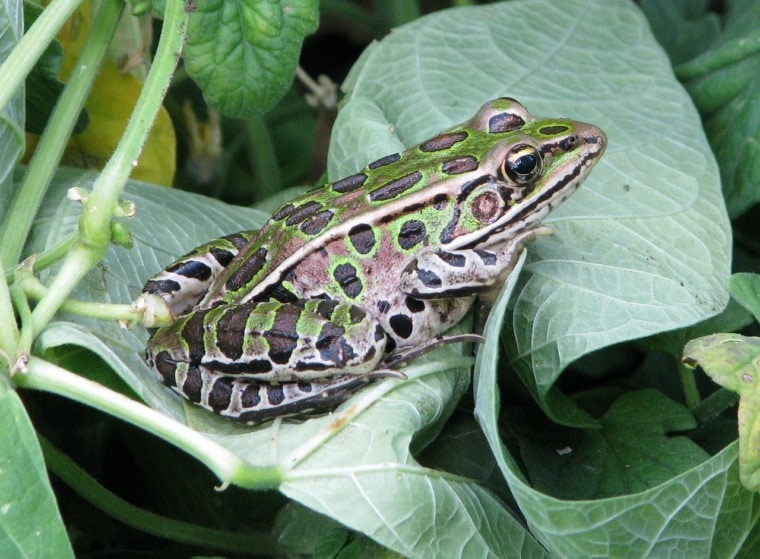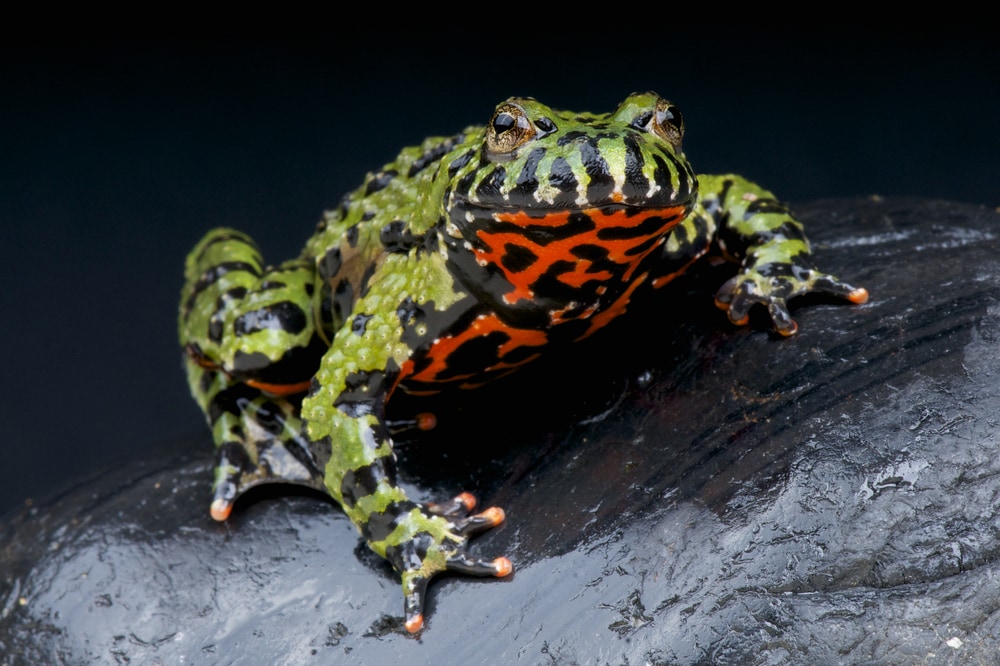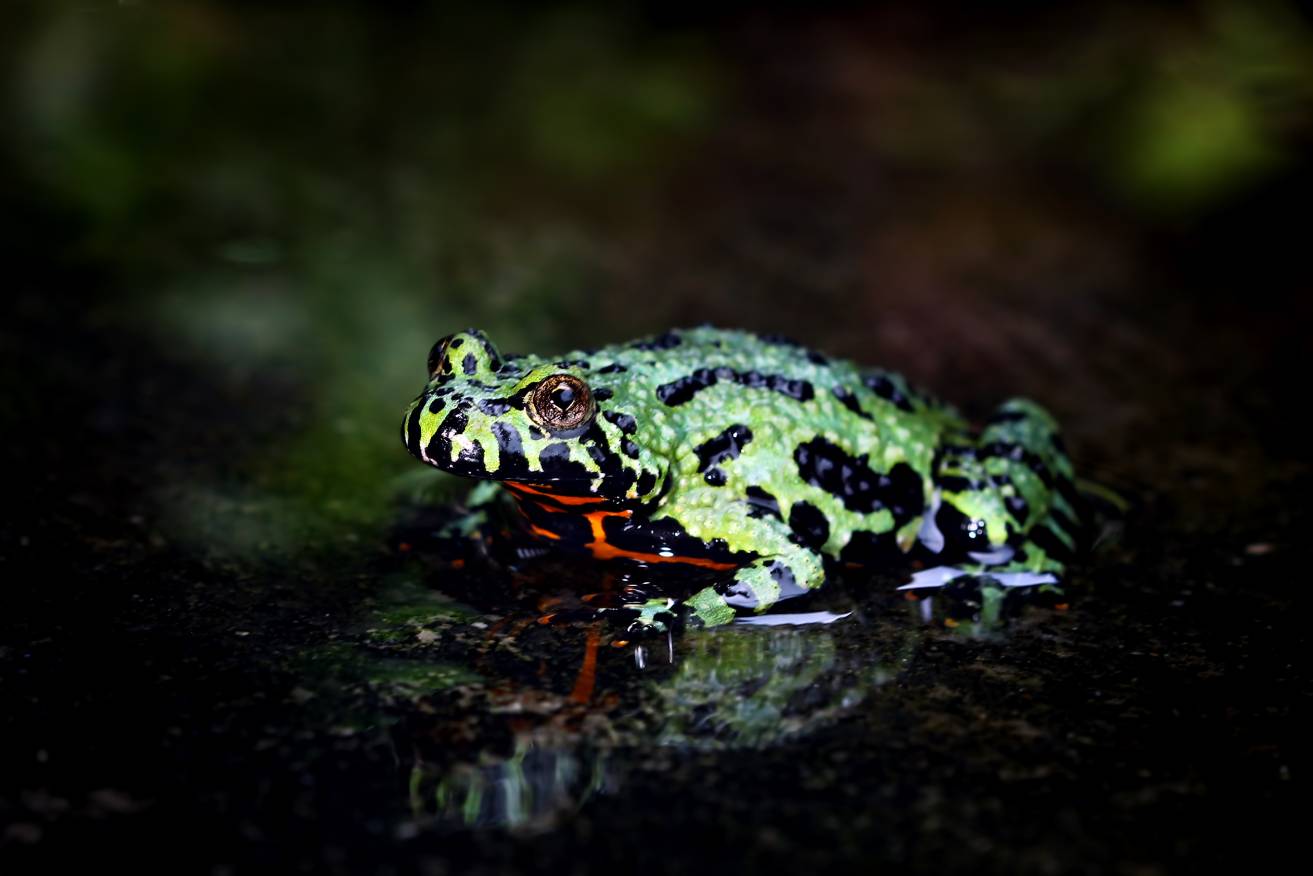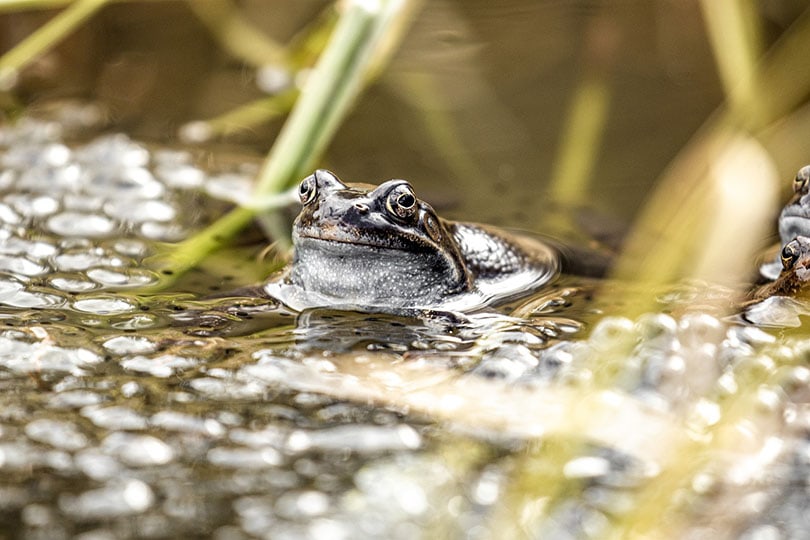
Leopard Frog is the name for several spotted frogs in the Lithobates genus. Each of these frogs has green or brown skin with spots that resemble a leopard pattern. You can find leopard frogs anywhere in the United States as well as many parts of Canada and Mexico. If you are interested in keeping one of these amphibians as a pet, keep reading while we look at behavior, tank size, habitat, and much more to see if they will make a suitable pet for your home.
Quick Facts About Leopard Frogs
| Species Name: | Lithobates |
| Family: | Ranidae |
| Care Level: | Moderate |
| Temperature: | 68–75 degrees Fahrenheit |
| Temperament: | Timid, easily frightened |
| Color Form: | Green, brown |
| Lifespan: | 8–10 years |
| Size: | 2–5 inches |
| Diet: | Beetles, ants, flies, worms, crickets |
| Minimum Tank Size: | 10–20 gallon |
| Tank Set-Up: | Land and water |
Leopard Frog Overview
The Leopard Frog can be any one of several similar small frogs found in the United States, including the Atlantic Coast Leopard Frog, Bigfoot Leopard Frog, Lowland Leopard Frog, Northern Leopard Frog, and many others. While it’s fairly easy to find these frogs anywhere—even in New York City—their numbers are declining significantly from what they once were. Some species are seeing conservation steps put in place to preserve the species.

How Much Do Leopard Frogs Cost?
The cost of your Leopard Frog can vary significantly depending on the breeder, species, size, and other factors. Some can cost as little as $6–$10, while others might be closer to $100. However, unlike cats or dogs, you won’t need to pay to get it spayed or neutered, nor will you need expensive vaccination shots or regular flea and tick medication, so frogs are pretty easy on the budget.
You will need to purchase a 10–20-gallon tank to hold your Leopard Frog, and you will need to increase the tank size by 10 gallons for each additional frog you want to add, which can be an expensive one-time purchase. You will also need to purchase and feed it insects or other live food regularly.
Typical Behavior & Temperament
Leopard Frogs are primarily nocturnal animals though they might come out occasionally during the day. This type of frog will eat just about anything it can fit into its mouth, including other frogs, but will primarily stick to insects, especially flies, crickets, and beetles. It’s non-toxic and won’t harm humans, but it may carry the salmonella bacteria, so you will need to wear gloves when handling it and wash your hands frequently. They don’t like when you pick them up, so you will only do it when cleaning the aquarium. While domesticated frogs aren’t prone to jumping, you should be prepared for them to jump 3 feet or more—they are quite the escape artists.

Appearance & Varieties
Leopard Frogs can have varying colors even in the same population, and many will change colors continuously. It has smooth olive or brown-colored skin with dark oval spots, the size of which can vary between species and a white or cream-colored belly. The body is slender with a pointed snout and long powerful legs. At one time, the Leopard Frog was one species, but as scientists used it for lab experiments, they noticed slight differences between them, and today there are more than twenty different species accepted as Leopard Frogs. Despite the differences, it’s easy to spot a Leopard Frog, and they all live near marshy land areas where there is plenty of shelter and food.
How to Take Care of Leopard Frogs
Habitat, Tank Conditions & Setup
Tank
You will need a 10 to 20-gallon tank to house your Leopard Frog and another 10 gallons for each additional frog you intend to house. Part of the tank needs to be wet so the frog can swim and dive, while another part needs to be dry so your frog can dry off and eat. Plexiglass is a great way to section off parts of the tank, and logs and branches can help your pet move from one area to another.
We recommend using a removable water tank so you can change the water and clean it every few days without needing to tear apart the entire habitat.

Temperature
You will need to keep the temperature in your aquarium between 70 and 75 degrees Fahrenheit during the day and drop it down to about 60 degrees Fahrenheit at night. It can be challenging to achieve these temperatures in some of the warmer areas of the United States. If you want your frogs to breed, you will need to hibernate your frog during the winter by lowering the temperature to about 38 degrees Fahrenheit for about 3 months.
Plants, Lighting, Humidity
Providing vegetation for your frog to climb on and use for hiding can help your pet feel safer and provide an environment closer to its natural one. Leopard Frogs are nocturnal, so there is no need to worry about adding lighting, and they enjoy a humidity level between 50% and 70%, which is what most of us have in our homes. Hence, there is no need for humidifiers or hygrometers.

Do Leopard Frogs Get Along with Other Pets?
We recommend keeping your Leopard Frogs far away from cats, but dogs shouldn’t bother them unless they get out. These frogs are quite timid, so you can house them together without worrying about territorial disputes as long as the cage is large enough.
What to Feed Your Leopard Frog
You can feed your frog nearly any insects available, and they will even eat worms. We don’t recommend serving caught insects from outside as they can contain harmful parasites. Crickets are the most popular and easy to find at pet stores. Experts recommend feeding the insect well before you give them to the frog to make them more nutritious. You will also need to coat the crickets with a calcium powder supplement shortly before feeding them to your frog.

Keeping Your Leopard Frog Healthy
Keeping your Leopard Frog healthy to reach its maximum lifespan of 8–10 years is not very difficult and only requires you to give them enough space in the proper temperature zone and feed them a few times per week. You can drop the temperature to allow them to hibernate or keep temperatures where they are, and the frogs will stay active throughout the winter.
Breeding
Mating occurs in the water and normally takes place as the frogs wake up from hibernation, so if you want to breed them in captivity, you will need to lower the temperature in the aquarium over the winter. As the female swims, the male will hang on to her back with specialized thumbs. Then, 2–3 days after mating, the female will lay several hundred to several thousand eggs in a large mass, and the male will fertilize them. Tadpoles hatch in about a week and become frogs in about 3 months.
Are Leopard Frogs Suitable for You?
Leopard Frogs make great pets that are easy to care for and live an amazingly long time. We recommend purchasing captive-bred frogs instead of catching wild ones because many of them are seeing declining numbers. The aquarium is not too expensive, and you might even have one lying around if you’ve ever had fish. Creating the habitat is not hard to make either, and you get to be creative with it, so it can be a lot of fun, especially for children.
We hope you have enjoyed our look into this American frog and learned some new facts. If we have convinced you to try one out in your home, please share our guide to the Leopard Frog on Facebook and Twitter.
Featured Image Credit: Pixabay









